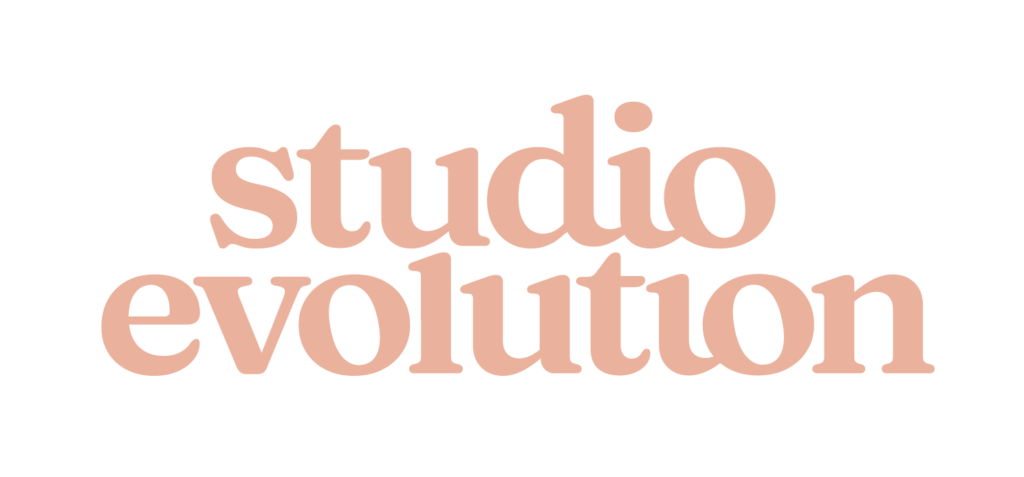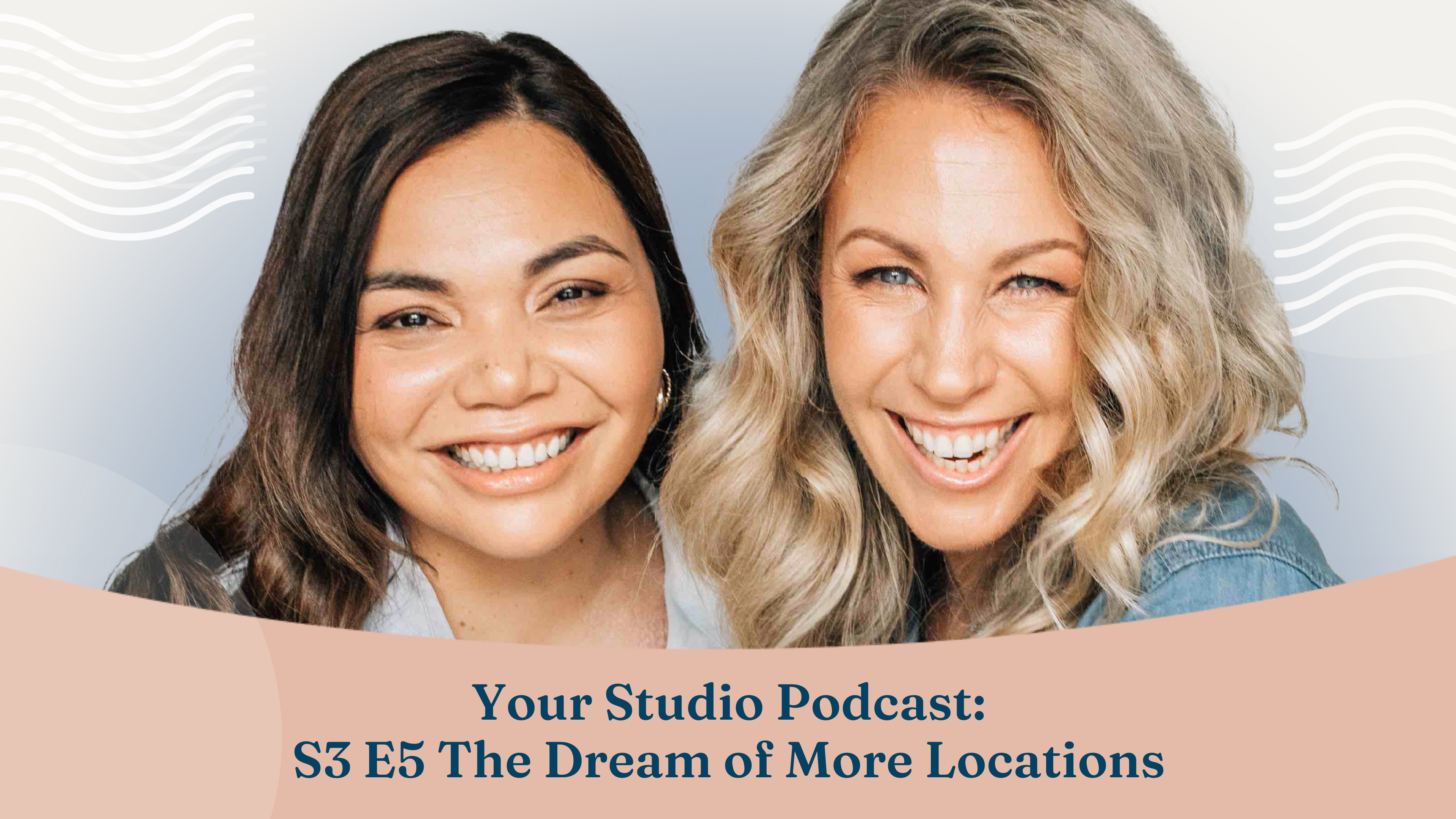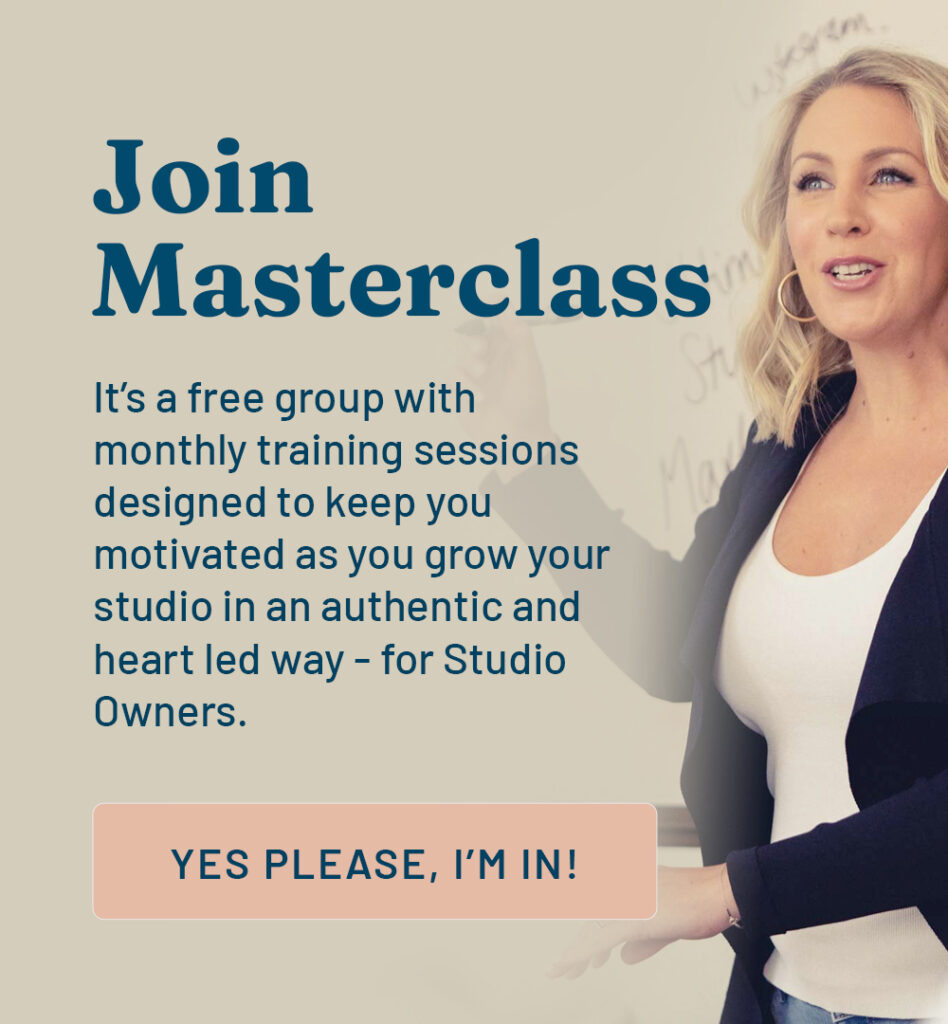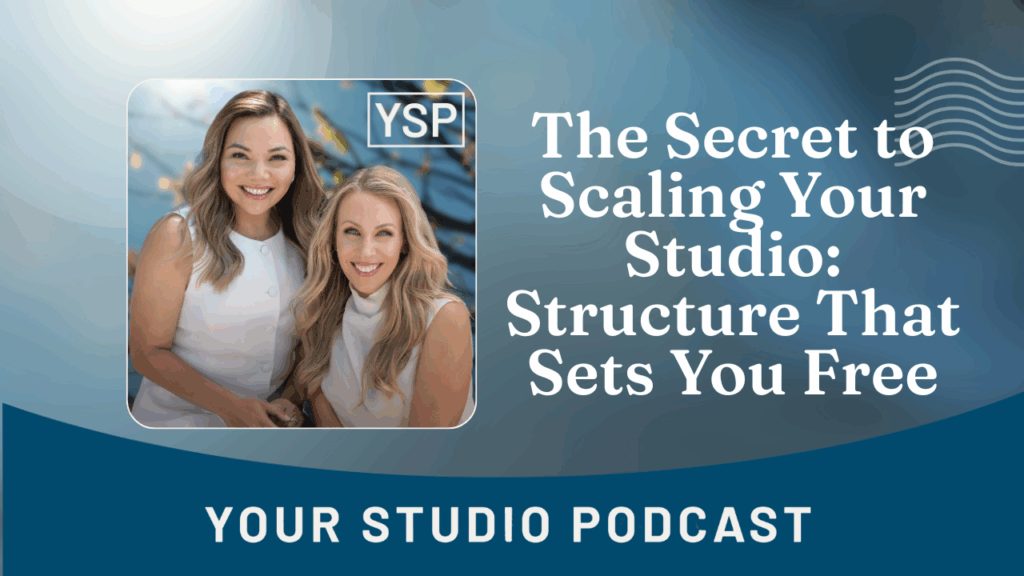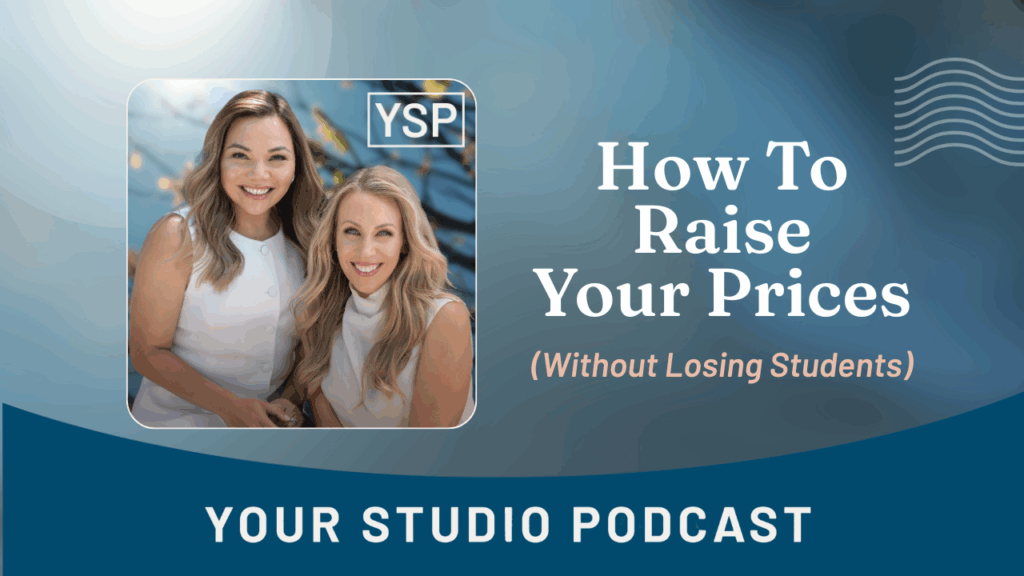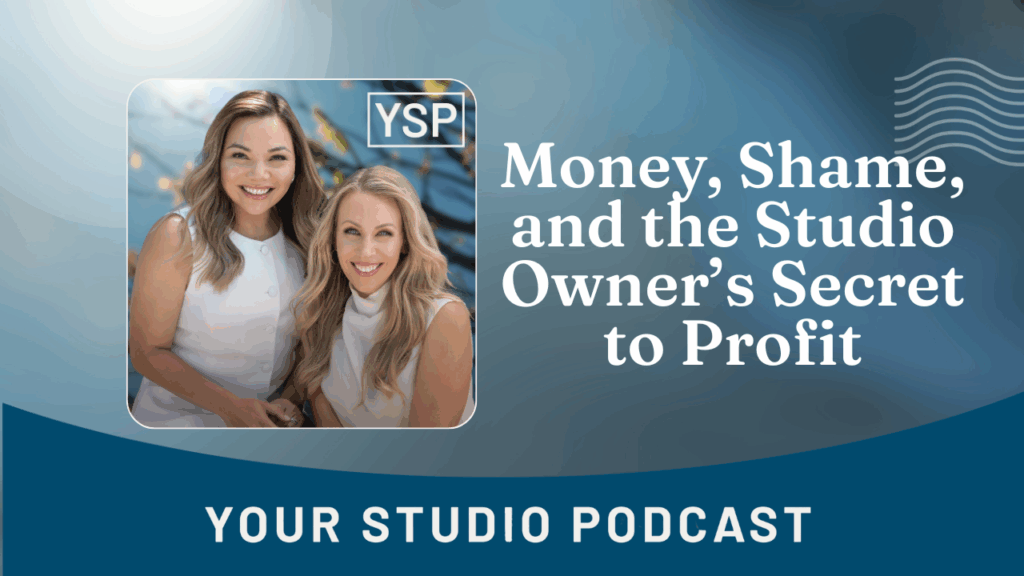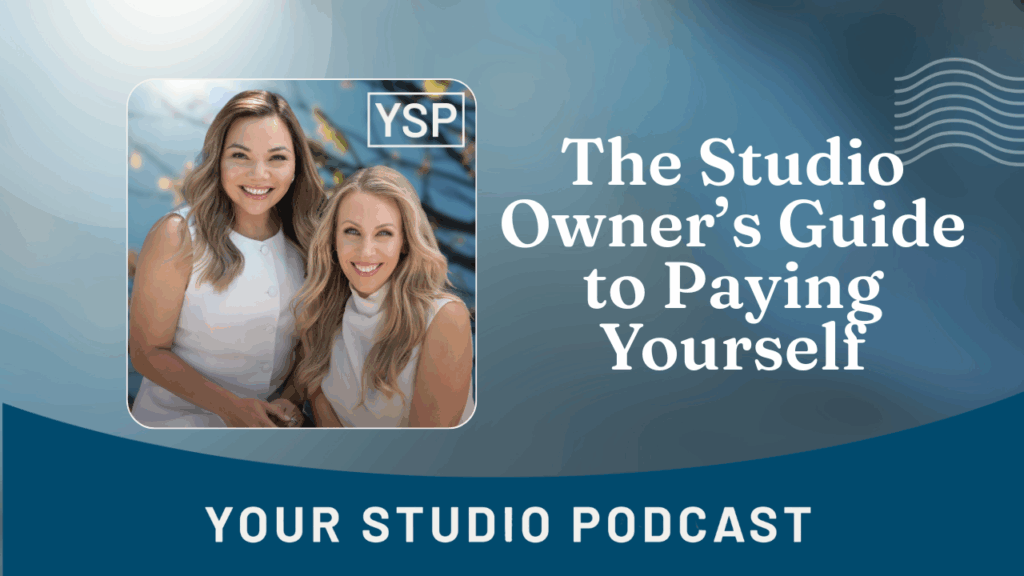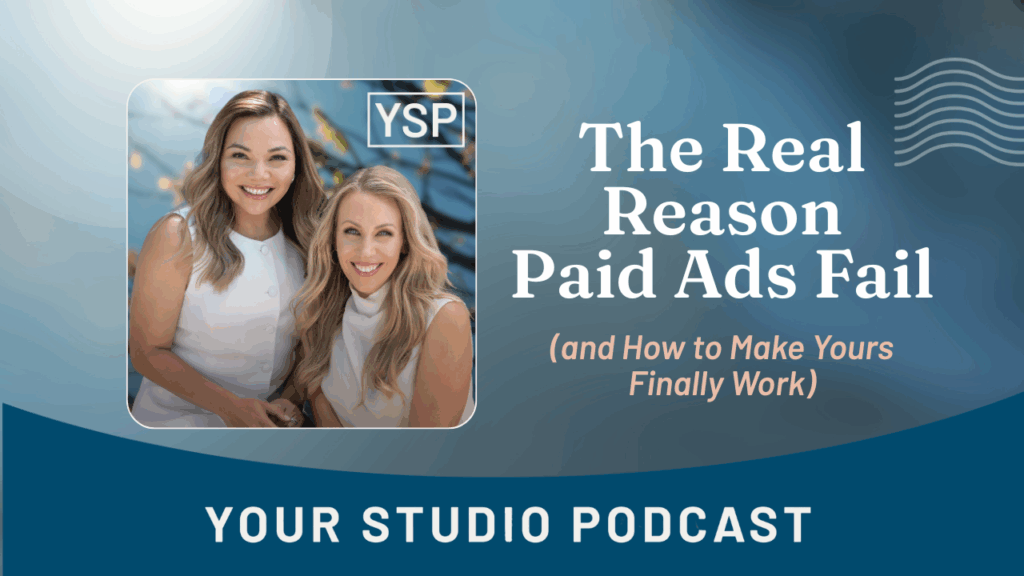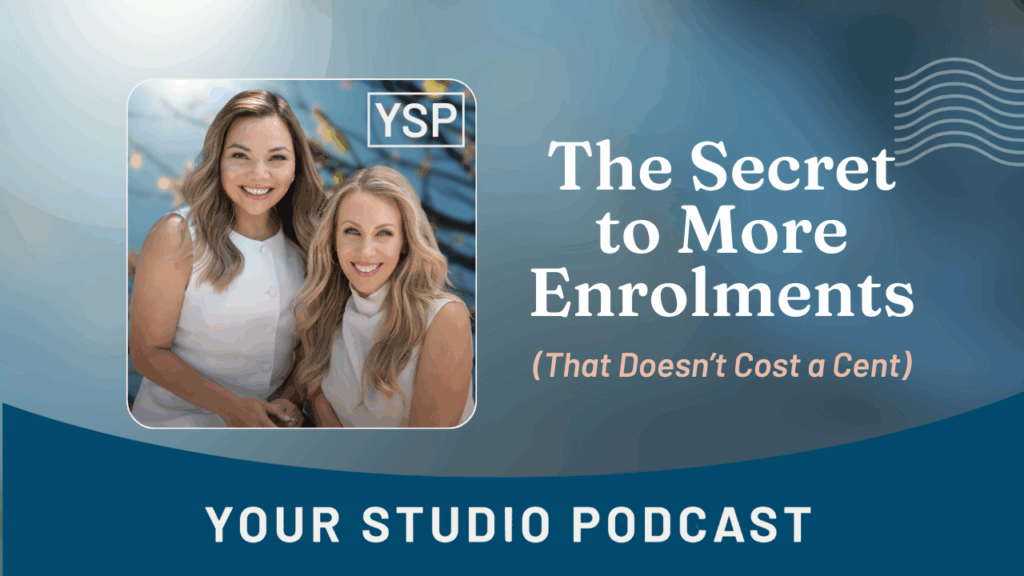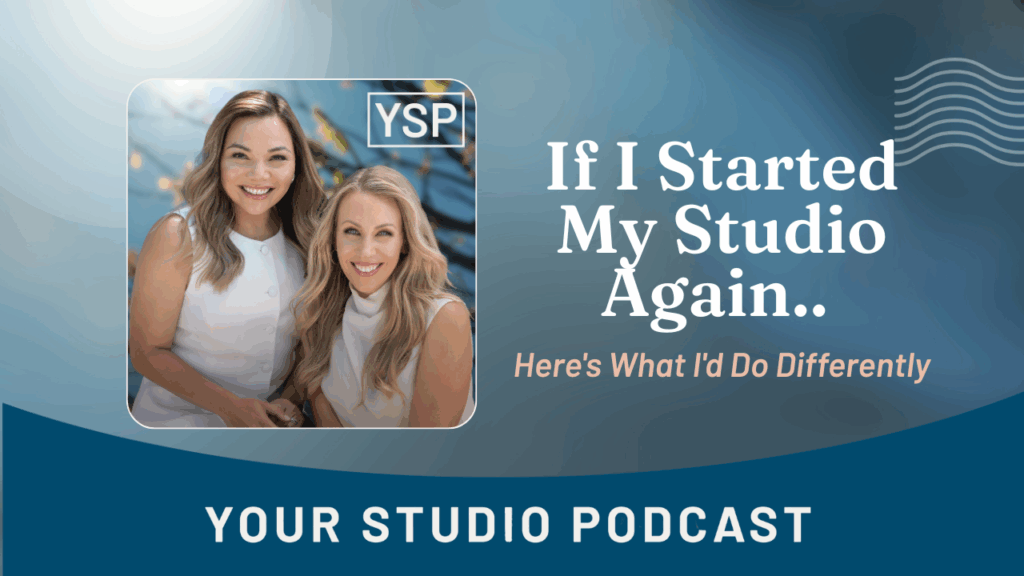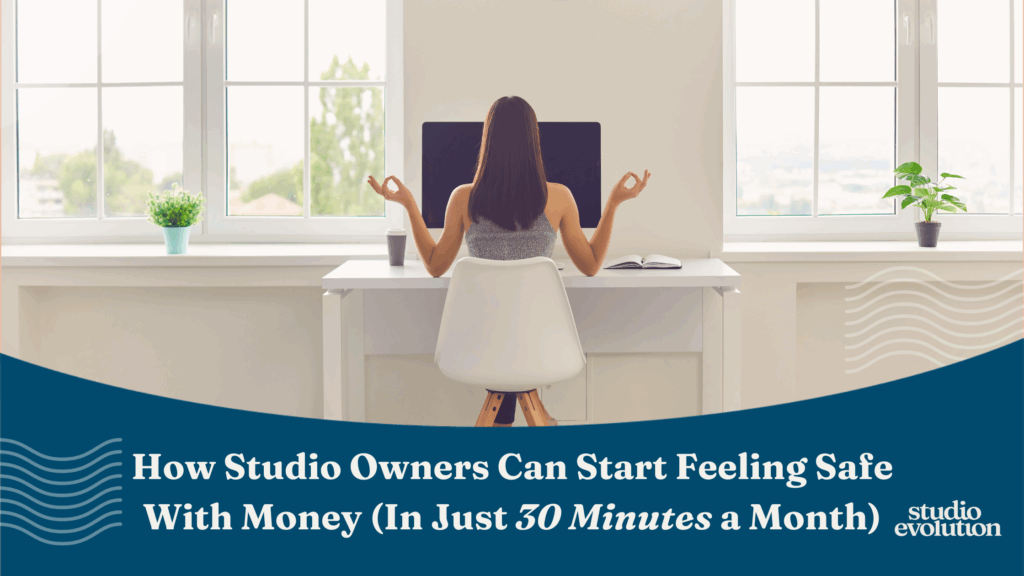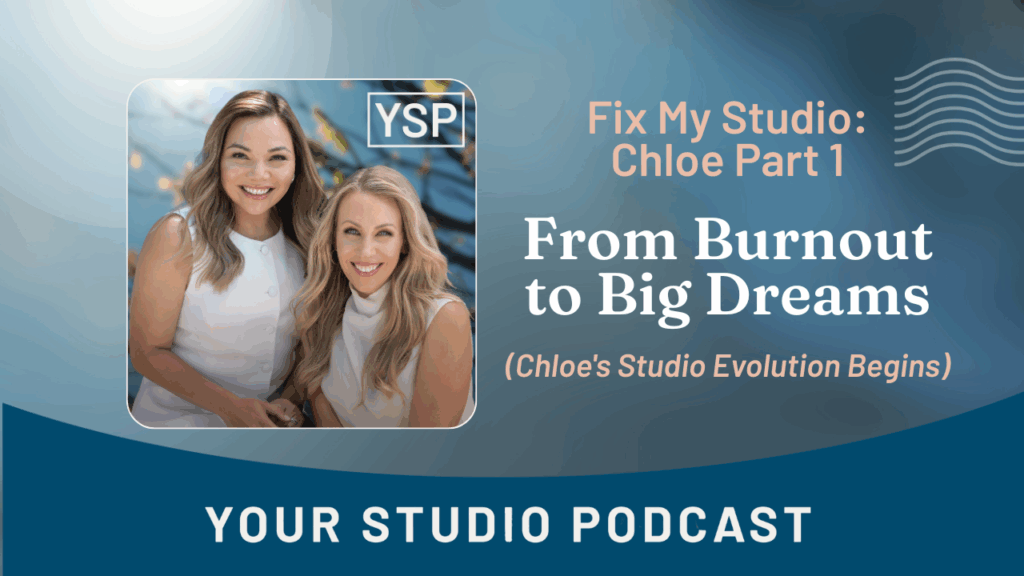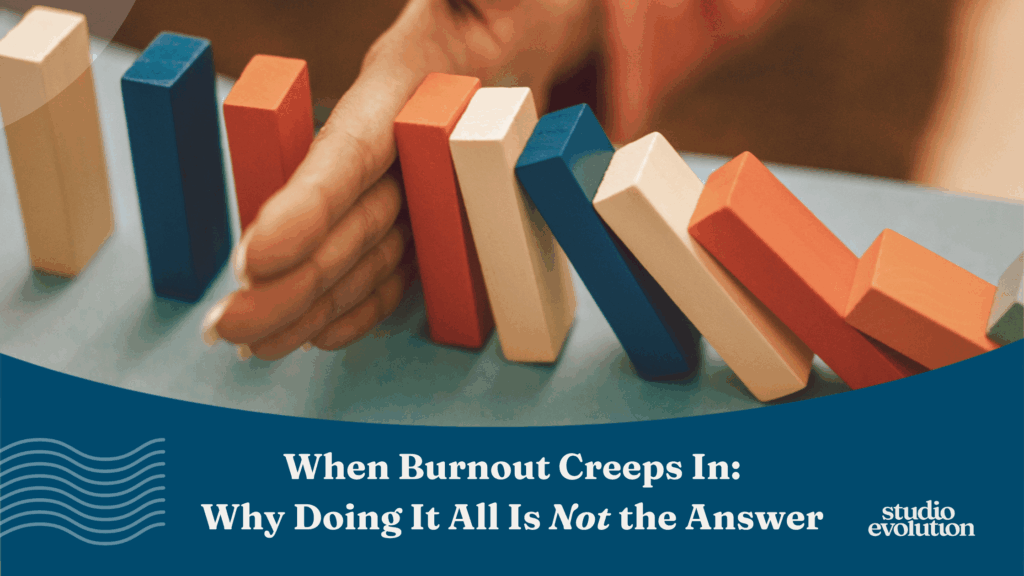Thinking about opening a second studio – or dreaming of many more? This episode unpacks exactly what needs to be in place before you expand, so your business (and your sanity) can thrive.
Chantelle and Michelle share real-world wisdom, lessons from six-location growth, and the systems that make it all possible – with plenty of laughs and lightbulb moments along the way.
✨ If you’re ready to build the kind of studio that runs like clockwork and grows with ease, apply for Studio Evolution at studioevolution.com/apply.
Please make sure to subscribe and review if you like what you hear!
If you’ve got a studio problem you’d like us to solve, leave us a voicemail here: https://www.speakpipe.com/LeaveEvolutionAVoicemail
Be sure to follow us for more content perfect for Studio Owners!
Instagram: @thestudioevolution
YouTube: @thestudioevolution
Facebook: @TheStudioEvolution
And if you’d like some more support, find out how we could help you here:
Website: studioevolution.com/start
Transcript:
Michelle Hunter (00:48)
Mav’s turning 10 this year. That’s huge.
Chantelle Bruinsma (00:51)
That means we’ve been together for nine and a half years. Yeah. Mm-hmm. That’s why I needed you.
Michelle Hunter (00:54)
Is that crazy? You met him, you met me when he was six months old. Man, I had no idea what I was doing.
my gosh, if I look back.
Chantelle Bruinsma (01:06)
Nearly 10, it’s next year, so next year is out next June or whatever is our 10 year anniversary.
Michelle Hunter (01:10)
That’s a 10 year anniversary. that’s like a
new beginning. my goodness. 10 years together. 100 % we’re doing something. Yeah, we have to. So special.
Chantelle Bruinsma (01:15)
We should do something to celebrate that.
That’s really special. We know we’ve talked about you
and I just going away for a couple of nights, not to put on an event, but just you and I going away for a couple of nights. Maybe that’s when we do it. It’s our anniversary. So I’m going with my wife. Sorry, husband.
Michelle Hunter (01:25)
Yeah, to hang out. We should do that. It’s our 10 year old. Oh, that’s such,
that’s so cool. Can you believe it? It’s like we’ve grown up like a lifetime together as well. Like we had a whole evolution of like leadership, personal, cause we had babies together.
Chantelle Bruinsma (01:34)
No.
I mean, you met me not as a mum
Michelle Hunter (01:45)
No, and you just had, you guys just got married. Like I was looking at your wedding video, remember? You were just like fresh up to your one year wedding anniversary. That’s crazy. You still lived in Mascot.
Chantelle Bruinsma (01:49)
Mm-hmm.
I know…
I know, in Terminal 3.
Michelle Hunter (01:57)
Yes! That’s a long time ago.
Chantelle Bruinsma (02:00)
It’s
a long time ago, a long time ago, I can’t believe that.
Michelle Hunter (02:03)
Like we’ve been
being friends like buying houses, like moving to our dream houses. Like that’s crazy even too to think about that. Like do you remember when we
Chantelle Bruinsma (02:07)
Yep.
Yeah, you
knew me living in a tiny two bedroom apartment in right near the airport to like and not even having children.
Michelle Hunter (02:15)
Yeah, and then I lived in that
house, like we lived in that smaller house and we always dreamed of having a bigger- that’s just crazy! That’s crazy.
Chantelle Bruinsma (02:21)
Point Cook, yeah, yeah. It’s become a long way friend.
I’ve just finished Meghan Markle, Meghan Sussex’s Sussex, Meghan Sussex is her name now. Six. it’s lovely. ⁓ it’s just like, it’s like so relaxing.
Michelle Hunter (02:26)
And I think, it’s Sussex. Yeah, yeah, yeah, yeah, yeah. How many episodes is that? Okay, it’s not too bad watching.
Cutting berries. Yeah,
because it’s just relaxing. You don’t have to think too hard when you watch things like that.
Chantelle Bruinsma (02:46)
My cup of tea, it’s all about kind of like entertaining and very domesticated life. And I’m all about that. All about that.
Michelle Hunter (02:50)
Yeah. Yeah. Awesome.
It’s funny what people watch to relax.
Chantelle Bruinsma (02:56)
Yes, like there’s two types of people in this world, like my husband who
I can happily watch the most horrific, horrific, violent and scary stuff, or those who need to relax to watch something that has zero stimulation.
Michelle Hunter (03:02)
Yep.
Chantelle Bruinsma (03:09)
much more your kind of whole food Meghan Markle kind of making your own kind of sun tea where she puts like dried things then you put the water out in the sunshine to let the sun make the tea. Like that’s so me.
Michelle Hunter (03:13)
Yeah
That
is so you. I love it. I love it. That’s how Chantelle gets a tea and I get like those dirty boba teas. And I love them. I love all those tapioca pearls that have been sitting in a bag. And it’s like reheated. But we work together. I know, I know, I know, I know. That’s them. I always get one on my birthday. That’s my treat.
Chantelle Bruinsma (03:39)
BLEH!
But yeah, I still really am tempted. to put in like proper kind of raised garden beds. And then I can, yeah, right.
Michelle Hunter (03:51)
Aww, that would be beautiful.
Chantelle Bruinsma (03:53)
and, you know, step into my full, yeah, I would have full veggies.
Michelle Hunter (03:54)
Would you have veggies? Yeah, 100%.
Yeah. I had a friend who used to sing to her veggie patch.
Chantelle Bruinsma (04:01)
I see that in my future.
Michelle Hunter (04:02)
I
was like, my gosh, is your future. those words came out of my mouth, you’ll be singing to your vegetable.
Chantelle Bruinsma (04:07)
Here is me hugging
the rosemary tree. Hello little carrots. Aren’t you cute?
Michelle Hunter (04:16)
That’s going to be the intro to our next promo reel.
Chantelle Bruinsma (04:19)
Homesteading
with Chantelle and Michelle How to make preserves with Chantelle. Your homesteading podcast.
Michelle Hunter (04:22)
my gosh, I’m so excited. We’re gonna get,
I think that’s gonna be like our next like personal evolution. Like we’re gonna, you’re have your veggie garden. I’m gonna be making my jams
you know how I go making churning my own butter. It’s all right. See, the laugh laughed because it was so unrealistic.
Chantelle Bruinsma (04:37)
The day you… The day? The day.
All right.
Michelle Hunter (04:44)
There’s not. All right, let’s go.
Hello friends. Welcome back to the Your Studio Podcast. It is Michelle Hunter here with my work wifey, Chantelle Bruinsma And we’re dropping in today to speak about a really interesting question and topic when as a studio owner, things may be going swimmingly great. And it’s knowing when it’s the right time to grow. Isn’t it Chantelle?
Chantelle Bruinsma (05:07)
Yeah, we have, this is probably a bit more of an advanced question, but it’s good to have this stuff rolling around the back of your mind when you need it one day, right? We have a lot of kind of people who graduate from Studio Evolution, our two year course and their studios are rock solid and their retention is great. The team’s amazing. Their classes are pretty full and they now kind of turning their attention to, okay, well what’s next? What am I going to do next? And maybe you’re someone who, you know, like me had always dreamed of having multiple locations.
Michelle Hunter (05:12)
Mm.
Yeah, for sure.
Mm.
Chantelle Bruinsma (05:37)
for their studio. You know when I started my studio, Born to Perform, I started with one location that floundered for years and then I kind of cracked the code. And then it was quite easy to add on additional locations after that. I was planning to grow to 24 locations was what I had mapped out in my head. I got to six before I sold the studio, because I got an opportunity to move to India, blah, blah, blah, blah, blah, story for another podcast day, right? But the key for me was,
Michelle Hunter (05:53)
Mm.
Chantelle Bruinsma (06:07)
If you get a very successful prototype, you just duplicate it. You just replicate that prototype again and again and again. And you have the marketing to dial it in. I knew how to get the team. I knew how to get the experience kind of working very well. So growing from one to two locations was actually the hardest going from two to three and three to four, four to five, five to six. That was a hell of a lot easier, but the most difficult stage to kind of navigate is going from having one location.
Michelle Hunter (06:25)
Mm.
Chantelle Bruinsma (06:35)
to two locations.
Michelle Hunter (06:37)
Which, that’s, that could sound wild to a lot of people cause six locations is a lot. what, first, hang on. Why’d you have 24 in your mind? When did that 24 number come from? Was it like an impact thing?
Chantelle Bruinsma (06:47)
Yeah, no,
it was because there was a studio business in the UK that I was fascinated by and they had dozens and dozens of locations all around the UK. And I had been really exploring how they did what they did and followed their marketing. And I kind of was very curious. I saw the success of that model and I thought that’s
Michelle Hunter (06:53)
Mm-hmm.
Mm-hmm.
Chantelle Bruinsma (07:13)
That’s smart and it’s not being done here. And so I kind of was like modifying their approach to kind of really fit in my philosophies and processes. But I knew that we could probably get 24 and I’d kind of done the numbers on revenue and size of team. And there’s so much efficiency, like when you’ve got, you know, six locations, 24 locations, you’re still having a centralised admin, right? You’re still having everything come back to one. There’s one team, core team who manages all of the enrollments, all marketing.
Michelle Hunter (07:35)
for sure.
Chantelle Bruinsma (07:42)
all kind of HR for team, like that’s all centralised. Like it’s actually not that much work. And the cool thing about when you grow is that the team at the first location is kind of your breeding ground to then open the second location. And then the team you’ve got at the second location, then you’re picking the kind of the star players to go open another location. So it is this natural kind of feeding. If you get really good team, then you’re just wanting to create more opportunities for them. I think that that was, that was why, I mean, I don’t know why that number, but it was just, I wanted it to be significantly large.
Michelle Hunter (07:55)
Mmm.
Yeah.
So I can see how you say when the biggest or the hardest jump was going from one location to the second and then so on. But let’s get to like what’s behind wanting to open another location.
Chantelle Bruinsma (08:25)
Yeah. Well, I mean, like the first thing is your kind of personal drive and ambition. Like if you’re someone who’s got big dreams and you know that you really want to be this type of entrepreneur who is, you know, has got a lot of drive and ambition, that’s going to be spurring you look for opportunities. And maybe you’ve seen a studio close in another suburb, or maybe you’ve got a team member who’s moving. And they’ve been like a heart of your studio, like, maybe I could just.
Michelle Hunter (08:30)
Mm.
Chantelle Bruinsma (08:50)
Usually it’s like opportunity based of you see a gap, there’s kind of a gap in the market that you’re aware of. you’re like, you know, I’m going to kind of going to take advantage of that. Maybe you’ve yourself moved and you kind of looking to have a location that’s closer to home. It’s maybe also, I know for other clients, there’s been like a big housing development happening in the area. like, they wanted to get in the ground early on, but I think the important thing is like these opportunities come up. And what I see happen is that.
Michelle Hunter (08:52)
Mmm.
Yep.
Chantelle Bruinsma (09:18)
they take advantage of opportunity but studio number one, their kind of home core based studio isn’t quite ready, you know what I mean Michelle? Like they’re kind of, there’s things that aren’t quite consolidated yet and that’s where things start to get a bit complicated.
Michelle Hunter (09:26)
Yeah. Yeah.
Yeah, okay. So, and that’s really, it’s just normal thinking. Like if you go to expand anything, you want to ensure that the core is strong and that the foundations are set before you build a second story on a house, right? That’s yeah, yeah. Like before you go up, you’ve got to make sure that the foundation is strong. What are some of the markers then that we should probably be seeing within studio business that shows that you’re ready for more locations? Like we know that there’s opportunity, but what
Chantelle Bruinsma (09:46)
I mean, what a metaphor, yes.
Mm.
Michelle Hunter (10:02)
what are the markers that we know that we’re ready to go into it?
Chantelle Bruinsma (10:06)
Honestly, it’s the biggest one is team, like hands down team. Because what’s gonna happen is that in my case and also what I’ve kind of observed from a lot of other studio owners, like when you’re opening a second location, usually to get this second prototype working, you’re gonna take some of your energy and put it over here.
Michelle Hunter (10:10)
Mmm.
Yeah, for sure.
Chantelle Bruinsma (10:29)
And so if
the studio number one has been largely running over your connections and your involvement and your kind of firefighting or kind of you’re observing things going on and picking them up and you’re kind of being there really supporting and holding the hands of your team members and you stop doing that and you put it over there, then suddenly studio one’s like, wheels fall off.
Michelle Hunter (10:47)
Yeah.
Yeah. Yeah.
Chantelle Bruinsma (10:51)
wheels fall
off and that’s the biggest mistake. So it all comes down to the team and systems. Can your first location really run like clockwork? Do you have a very stable devoted team? Do you have systems that really are supporting the team to know exactly how to do this? Because this is all about culture. If you think about it from that perspective, like your job is to make sure the culture of Studio One is self-sustaining. Can that first studio continue to
deliver the experience day in, day out, week after week for every single student, every single class. Can you like, could you go away for a month with a bit of prep and a bit of handover for sure, but could the studio really run effectively? If you can do that, that’s a really damn good indicator to let you know that you’re ready for a second location. So I think what I’m saying, Michelle, is this is my permission slip for you to book a month’s holiday to seek evidence.
Michelle Hunter (11:47)
I was just going to say that. Yeah.
I was like, that is the perfect project. If you’re listening and considering book a four to six week holiday with a, with a handover to your team and see if they can do it. And that is really telling. It’s funny. A lot of members in our Evolution program, when they’ve had babies of they’ve gone on holidays, that’s pretty much been the precursor to them to, for more expansion. Cause they know their team is rock solid.
Chantelle Bruinsma (12:04)
Yep.
Uh-huh. It’s the best way to give you the confidence of whether you’re ready or not. I love it. So, I mean, it is, it is seeking to see, I have retention stability? You’d be from, if we’re kind of pure numbers, if you’re kind of looking for that, Michelle, like in terms of capacity, I’d be wanting your studio to be at 80 % capacity minimum before we kind of look for another location. I don’t need you to be at a hundred percent. I think you could be kind of really at a solid point.
Michelle Hunter (12:28)
Gotcha.
Yeah.
Chantelle Bruinsma (12:36)
And 80 % capacity. that means like of all your time, if you looked at all your timetables or your timetable, sorry, your entire timetable and you looked at every class and you took the maximum number of students you could possibly have in every class over across your entire timetable and you took that number and then you select the number of classes taken. That’s going to give you a percentage of total capacity. And so I’d want 80 % of spots across all of your classes in your entire timetable full.
because that’s gonna give you, you don’t have to work that hard for enrollments. You’ve got a good baseline. Of course, if you’re above that, that’s a really good sign, but I don’t think you need to get to 100 % before you open the next location. I really don’t. It’s be too hard.
Michelle Hunter (13:14)
Yeah, yeah.
And
what about now this is a whole nother strategy. Cause like, you know, you’re ready. You’ve seen the markers, you’ve gone on the holiday, your team’s solid, your capacity, like the whole process of knowing where to, where to put roots in, like where to go finding that second location. This is a huge, this is a huge consideration.
Chantelle Bruinsma (13:24)
Okay.
⁓ yeah, yeah, yeah.
Yeah, strategically there’s a bunch of different ways we can play this. So there’s a few schools of thought that we can talk through. The first one is what I would call the satellite strategy. So the satellite strategy is having close proximity locations. So I’m talking within a 15 minute drive maximum around like less than 15, 20 minutes. You can even have less than that.
Michelle Hunter (13:55)
Mm-hmm.
Chantelle Bruinsma (14:11)
Now the benefit of having the satellite strategy, we have this like central home location and then like not very far for them to go to other locations. The benefit of that is that it’s very easy for team. You can have your team members kind of go to different locations without them having to do big commutes. It also means the other benefit of this is that you can actually kind of have from a makeup policy or kind of a, an ease like, ⁓ there isn’t availability of this class on this day, but there’s one just.
nine minutes down the road at this studio location, you can go there. Now that you might be listening to this going like, why would I go 15 minutes away? But here’s the other thing that we benefit from. So because you’re local businesses, if we have a lot of awareness in a kind of, in a, we’re going to reach like a threshold of, of awareness and real dominance in fact, in the area. And that is worth so much.
Michelle Hunter (14:55)
Yeah.
Yeah.
Chantelle Bruinsma (15:06)
So being able to think of, you know, like, there’s six different locations within this kind of 30 kilometers. And what happens is everyone talks, I’m going to this location, I’m going to go this one. And the word of mouth that goes within that vicinity just explodes. And you can really become, step into a really strong prominent position if you go down that way.
Michelle Hunter (15:28)
We’ve seen a lot of studios that word that you just used, dominate using the satellite strategy. And at first it’s like, what what do you mean so many in a close proximity? but it does just what you’ve said. You’re pretty much covering all corners of that region.
Chantelle Bruinsma (15:33)
Mm-hmm.
Will you give the convenience of like, let’s say someone’s borderline on between two locations, they can choose what’s most convenient for them. So you’re kind of doubling options for people. So you’re eliminating so much of the kind of what can hold people back versus we could choose another way, which is we choose like maybe there’s a big housing development 40 minutes away that’s opening up or an hour. There’s a lot more commute for your team that they’ve got to do.
Michelle Hunter (15:45)
Yeah.
Yep. Yeah.
Chantelle Bruinsma (16:08)
We also can’t kind of rely on the word of mouth from that area kind of helping to grow that next location because there’s no connection. You’ve then got to be sourcing team or paying for team commute. And as a studio owner, it’s really hard for you to go pop in and out. Like for Born To Perform for me, like every location was in 15 minutes of the other one at least. So I could just kind of do a train. go one, I go two, I go three, I go four. I’d usually get through like four locations. I could just pop in two in a day quite easily, right?
Michelle Hunter (16:31)
Yeah.
Chantelle Bruinsma (16:36)
And just be there for half an hour, 45 minutes, see it’s all going, see you later on my way. But that’s, I probably prefer the satellite studio approach versus kind of opening another side of the city. It’s just in terms of the word of mouth marketing growth, I’ve seen it be less effective. And even if you think of online advertising, like ads, ad strategy, you can, again, if they’re in one particular kind of group of post codes, you can just dominate, right?
Michelle Hunter (17:03)
Yeah, dominate.
Chantelle Bruinsma (17:06)
versus if you’ve got more population, more spread, it’s gonna cost you more to get the same level of impact.
Michelle Hunter (17:12)
You’re exactly right. And when we talk about like an ad strategy, so for instance, if you’re a bricks and mortar studio and you’re running a Facebook ad, you can actually, you know, type in the region and the kilometers and miles of where you’re trying to targeting for that studio. If you are opening a studio like Chantelle said, but the second option, which might be 40 minutes away, you’re pretty much having to run two sets of ads to target those two separate regions. Cause that would fall under two different areas. Yeah.
Chantelle Bruinsma (17:22)
Mm.
Yeah.
So you’re going to have, it’s going to cost you so much more and the complexity.
Michelle Hunter (17:40)
Yeah.
Yeah. With the satellites and word of mouth strategy is one of the strongest marketing tools to this day. And it’s cheap if you do it right. Yeah.
Chantelle Bruinsma (17:49)
If you do it right.
I mean, the other way you can kind of look at this is, what is successful is if you get to capacity at your home location, like a lot of our clients get to they’re filled they’ve got no more time on the timetable for like, let’s say you’ve got a really successful Tiny Tots program or introductory program, and you just can’t fit anymore people in. You might have availability in your older classes, but none at the kind of bottom end of the studio, ⁓ program suite The other way is to open feeder locations. So you’re going to.
Michelle Hunter (18:02)
Hmm. Yeah.
Chantelle Bruinsma (18:19)
not rent a whole premises but you just, maybe you can kind of take an hour here at like, know, even like Pilates, you do mat class at a church hall or rent a school hall, or, you know, you’re kind of doing having a little bit more kind of like, so you’re taking the brand and again, offering classes in a small distance away, but you’re allowing more volume to come into the studio. And then when they kind of ready to go into the main program, they come to the kind of the home.
base studio. That’s another incredibly effective strategy that we roll with clients for sure.
Michelle Hunter (18:49)
And clients who have done this with us in Studio Evolution Chantelle, what’s the key for that success so they make when they do those feeder programs at the smaller venues that feed into the main studio, what have they done that really makes that successful in regards to the feel they’re making? Cause cause like if it’s the feeder program, they still, they do an incredible job because when they come to the concerts and stuff, they are all one. So what do they do that makes that so successful?
Chantelle Bruinsma (19:04)
Yeah.
Mm-hmm.
Well, yeah, there’s a lot of resistance. work through with clients on this because they feel like, Oh, but they’re not going to be at the main studio where it’s all painted and there’s couches and it looks so beautiful. Like it’s like a second rate experience being in this shoddy little hall. it’s like, ah, ah, ah, ah, ah, ah, ah, ah, ah, ah,
Michelle Hunter (19:18)
Yep.
Mm-mm.
Yep.
Chantelle Bruinsma (19:42)
have a day rate for, right? Now you can create that experience wherever you are. And it’s just about being a bit creative. Like you have a folding table, you have a lovely table cloth, you bring out the resources, it can fit in a tub, right? There’s the ways to really create that consistency of experience. They’re not missing anything. They’re not, they’re not coming for that. Like you can create it through the warmth and the relationship and through the visual elements that you bring out. But it’s more about choosing.
convenient locations, think is probably increasingly something I’d be prioritising. Like I was having a chat with another client the other day and she’s ready to open. I think she actually just signed on a second location and the importance of, you know, choosing a place where they can come to Pilates, then they can go get a cup of coffee, take away coffee before they go to work. And there’s the little grocery shop just up the road. They can just walk up, grab a loaf of bread, grab some milk before they head home.
Michelle Hunter (20:33)
some put it.
Chantelle Bruinsma (20:37)
That level of convenience is incredibly important. Parking! Like, I’d be choosing a location based on quality of parking, you know?
Michelle Hunter (20:42)
It’s huge.
Well, I know
a lot of, a lot of gyms as well, like a small boutique fitness. That’s like the biggest criteria is parking. When you have like an adult gym, like I know with a lot of, you know, ⁓ younger schools and children studios, you can, you can get away with little drop off and pick up when the helpers come out. But like with adult gym, you need parking. It’s so important. Yeah.
Chantelle Bruinsma (20:52)
Yeah.
Yep. Yeah.
So, I mean, again, you’re going to choose somewhere that’s kind of, I would recommend within a small kind of driving distance, but that again, retains the feel that you want to create and all you, how you can create that space now. But again, this is only successful if you’ve really got the systems that have created and dialed in the systems that have made venue number one successful. And what a lot of people join Studio Evolution for is that like,
I’ve got this beautiful studio, it’s doing well, but it all relies on me. And if you feel like you’re the kind of secret sauce, the magic glue holding it all together, it’s difficult to replicate you. It’s really difficult to clone you and to have that magic that you bring. And if what happens then is so you open location number two and you find yourself running like a headless chook between those two trying to bring the spark or bring the energy, bring everything that’s not going to work.
Michelle Hunter (21:36)
Yeah.
Chantelle Bruinsma (22:01)
So we can’t open a second location until you know that location number one has that magic delivered by the team. You with me? It’s big huh?
Michelle Hunter (22:09)
Yep.
It’s, it’s Look, it’s big, but it’s, you know, what I love about this, you’ve been through this whole situation. You’ve been through this actual exercise before, and, you know what works.
Chantelle Bruinsma (22:22)
Well, it’s kind of finding the minimal viable number of components, right? How can you deliver the most beautiful student experience every day with the least moving parts? Like that’s how this is going to work and be very prescriptive in this is how we do things. Like when you’re growing past one location, you need to be incredibly prescriptive about how we greet things, how we start the beginning of class, how we end classes.
You know, what is the process when things go wrong? Your team have to be able to handle the shit as well as deliver the good is the truth. You know, that’s how you’re going to know that this is going to work. And when you do have multiple locations, you know, there’s a few options with the team of how you can structure this. Like sometimes it’s really good to keep your best performer, your best team member at your first location. They’re the stabilising consistent.
Michelle Hunter (22:59)
⁓ completely, completely.
Chantelle Bruinsma (23:21)
face and then you take yourself over to number two. Other way you can do it is you take your best performer from number one and you lead them to open number two and everyone else stays the same at number one and that kind of team member starts growing location number two. So there’s a few different ways to how to structure the team. How I did it for my studios was everyone had to do at least six months kind of at a base level and then after that they could apply for becoming like an assistant.
leader where they’d have some responsibility, they had some management, kind of they had to do things, but they were still very much teaching, but they had some kind of more duties as well. And after six months of being in an assistant position, they can then go to a leader, a leadership role, and they had to do six months, maybe a bit longer in the leadership role. And then once they’d done six months of the leadership role at one venue, they could then go become either would be open up a whole nother location or become an assistant for a brand new location. And so I had this built in
Michelle Hunter (23:51)
Mm-hmm.
Chantelle Bruinsma (24:19)
Ascension model when people were hired, I walked them through here is the pay progression. So if you do this amount of time as a, you know, kind of a camp leader and then you go to assistant and then move up into a manager role. And that had accompanying pay rate. So everyone knew that this is the path. Like we’re going to grow this studio and here’s how you’re going to do it. So everyone was on the same page of what was required and where we’re going to go. And I needed them to be able to grow the business. I needed them being aware of you’re responsible for delivering.
Michelle Hunter (24:20)
So great, yep.
Yeah.
Chantelle Bruinsma (24:49)
this experience is not on me and if you want to do it successfully, here’s where your career can go alongside me.
Michelle Hunter (24:55)
That is awesome. And what a gift, Chantelle. That’s so clear. It’s like they know where they’re heading and you kind of get people on the bus with you straight away or not. It’s like, yeah, this is, this is great.
Chantelle Bruinsma (25:04)
And
some people were very motivated for that. Like they knew that they were ready to kind of go and open the location. They, kind of like, could just see that the trajectory really well. And then it got to the point. I had a studio manager overseeing everything. So all locations. So lovely Anna. Anna would kind of be across, she kind of handled enrollments and kind of like making sure the team had everything that they needed. So I didn’t even have that responsibility. So there was even kind of someone who was off. She used to be a venue location manager and then she.
Michelle Hunter (25:07)
I could imagine.
Mm.
Chantelle Bruinsma (25:33)
kind of got promoted to across the board. And again, like that’s the second tap of just everything goes smoothly. Everything is very consistent. It was easy. Like it sounds funny, but it was actually getting to six locations was a hell of a lot easier than when I struggled with one.
Michelle Hunter (25:47)
that like your leadership, it’s a wonder. It is an absolute wonder. And if you’re a studio owner listening in and wanting to extend your leadership skills and you want a rock solid team and to be one day to expand your locations, we would really encourage you to look into our flagship program, Studio Evolution. And that is that terracotta binder right behind Chantelle.
Chantelle Bruinsma (26:14)
Yes. So this one here, this Terracotta binder is the Evolving Leaders one. to be honest with you, we need all of those things. We need your profitability, we need your retention, we need your leadership, we need your finances, we need your marketing, we need your systems, everything just like getting it all locked in. Even if like, you’re not kind of wanting to grow to multiple locations, even if you want to sell this business, you know, getting all of these systems happening on automation, the marketing happening on automation, getting the
retention happening, just flowing. You need to have all those things to be able to demonstrate to a buyer that you’re going to get top dollar. So we have a lot of people who join our program because they want to grow to multiple locations, but they know right now they are just doing all of themselves. They need more stability. Some people join because they want to sell, they want to transition. And those two reasons are like, we’re going to lock down the prototype of this business. It’s kind of like McDonald’s, right? I think of it like that. Like there is no gray on how you make a cheeseburger around the world.
Michelle Hunter (27:11)
No,
Chantelle Bruinsma (27:12)
Like there is
Michelle Hunter (27:12)
no.
Chantelle Bruinsma (27:13)
like, it’s like 45 seconds on this side, it’s cooked for, and then it’s flipped over for another, like, know, 52 seconds. Like it is prescriptive and getting your business to that place where there’s so much heart, but prescriptive processes of how we do things. And this is how we get 85 % retention. And this is how we achieve 15 % pre-tax profit. And this is how you enroll 200 new students every year with the marketing. Like that’s the type of thing when you know that can happen, you can live your life.
Michelle Hunter (27:18)
Yep.
Yeah, and you got a beautiful business at the end of it.
Chantelle Bruinsma (27:41)
It’s really pretty great.
You really, really do. So if you’re kind of, again, just to sum up, if you’re ready to go to another location, the first thing you want to consider is my team and my systems. Like really thinking about that. And in Studio Evolution, we can show you a whole deep approach to fundamental scaling of studios that is going to make it easy for you to achieve your dreams and, and feel such confidence that you can. It’s also really cool to be in a community that normalizes success and that where
Michelle Hunter (28:13)
Mmm.
Chantelle Bruinsma (28:14)
You’ve got a dream to kind of go to this, this amount of locations. Like, yeah, this is what we’re doing. This is where we go and have people cheering you on and not questioning your capacity or not holding you back from like, do you think you really, you could have six locations? Like bloody hell you can.
Michelle Hunter (28:31)
You can, and running a studio does not need to be a labor of love. It’s not a badge of honor to suffer. And you can be in a community where we are real on what happens at the day to day as a studio owner, but you know, the sky is the limit.
Chantelle Bruinsma (28:44)
Because sky is the limit when you’re surrounded with people who kind of are lifting you higher. That is the truth. So head on over studioevolution.com forward slash apply. You can start evolution today and we can get you going and start building this business of your dreams and making the reality of what your business is capable of achieving come true. That’s what excites me actually, Michelle. It’s like your business has so much bloody potential and you know it, maybe not everyone around you knows it, but you know what this business is capable of achieving.
And what I love in seeing in Studio Evolution is actually unlocking, it’s like opening the door to what the studio has the potential to become, making it happen. Love it. So good.
Michelle Hunter (29:23)
Love it.
Thank you. And thanks friends for tuning in for another episode of your studio podcast. We’ll catch you soon.
Chantelle Bruinsma (29:29)
See ya!
